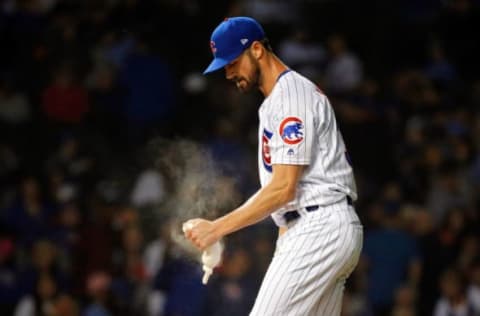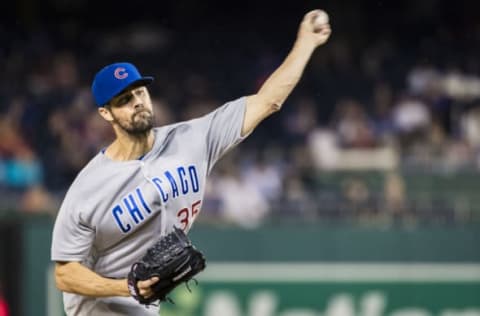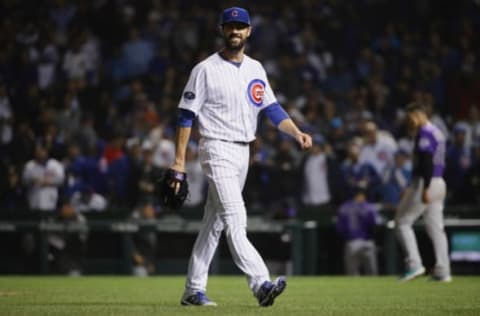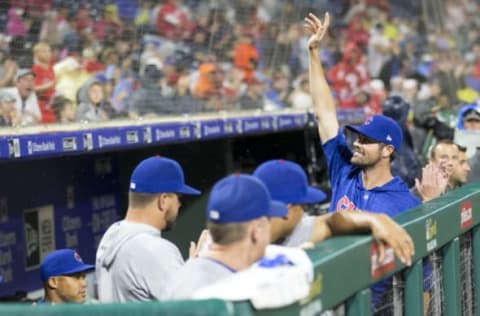Chicago Cubs had no choice but to pick up Cole Hamels’ option


Initially, some believed the Chicago Cubs should have let Cole Hamels hit the market and re-sign him to a team-friendly deal. That is no longer the case.
If the Chicago Cubs wanted to keep Cole Hamels for 2019, they had to pick up his $20 million option. It might have been reasonable at one time to hope that the Cubs could have re-signed Hamels as a free agent to a more team-friendly deal. But the early indications of this offseason are that in this pitching market, a free agent contract for Hamels would have been a worse choice than picking up his option.
The Cubs front office probably tried to negotiate a contract extension with Hamels before the deadline for making a decision about his option. Hamels said that he was open to a contract extension with the Cubs.
The kind of contract they would have been offering would have paid Hamels less per year than his $20 million option, but it would have had more guaranteed money because it would have been for multiple years.

Chicago Cubs: It was hardly a cut-and-dry decision
However, it would not be surprising to learn that Hamels wasn’t interested in an extension. Hamels’ option had a $6 million buyout if it wasn’t picked up. So if the left-hander could find a deal for over $14 million in 2019 he would have been paid more than his $20 million option as long as he didn’t agree to an extension.
What made the Cubs’ decision on picking up the option so complicated was that if they didn’t then the Rangers were going to pay $6 million buyout. But if the Cubs picked up his option, they were going to pay the entire $20 million themselves. Those were part of the conditions of the trade that brought Hamels to the Cubs.
That caused many to speculate that the Cubs should let Hamels become a free agent and get paid his $6 million buyout from the Rangers. Then the Cubs could turn around and be the team to pay Hamels over $14 million for 2019 (as part of a multi-year deal). That way Hamels gets paid more and the Cubs get to keep him for less than $20 million in 2019.

Chicago Cubs: A cost-cutting move that was huge
However, there were a few problems with this scenario. This maneuver could have damaged the working relationship between the Cubs and the Rangers front office. The Cubs and the Rangers have had a great working relationship that has resulted in a lot of good trades for the Cubs over the years.
On the other hand, the Cubs front office may have ended up applying pressure to encourage the Rangers to trade for Drew Smyly. That trade saved the Cubs Smyly’s $7 million salary. The Cubs then picked up Hamel’s option. That saved the Rangers $6 million they would have spent without having anything to show for it.
If Hamels reached free agency, he would have been one of the best pitchers available. Yes, part of that status would have been based on his improved performance after he was traded to the Cubs in a very limited time frame. But in a similar move, a change of scenery reinvigorated Justin Verlander‘s career. Verlander is still going strong a year later.

Chicago Cubs: Lessons to be learned from this winter’s signings
Hamels is already 34 years old. So the Cubs would have been trying to get him to agree to a short two or three-year deal. Perhaps the Cubs are only going to want one year of Hamels at $20 million rather than the millions more and additional guaranteed years it would have cost to sign him as a free agent.
More from Cubbies Crib
- Cubs starting pitching has been thriving on the North Side
- Make no mistake: the Cubs are very much about power hitters
- Cubs are giving pitcher Javier Assad a deserved shot
- Cubs: It’s time to start thinking about potential September call-ups
- Cubs: P.J. Higgins deserves to be in the lineup on a daily basis
But Patrick Corbin‘s free agent contract this offseason shows us that if Hamels became a free agent he might have been able to command a much higher salary per year and longer commitment than the Cubs would have been comfortable with.
Corbin’s contract is for six guaranteed years. In some ways, Corbin’s contract is better than the contract that Jake Arrieta signed just last offseason. Arrieta’s complicated contract only has three guaranteed years and then two team options plus a player opt-out. That is a clue that this year’s free agent pitching market is tougher than last year’s.
True, Nathan Eovaldi just signed a more team-friendly deal with the Red Sox. However, Eovaldi admitted he was prioritizing the Red Sox. If the Cubs would have allowed Hamels to become a free agent, they would have been counting on a similar post-trade-hometown-discount. Perhaps Hamels would have felt some gratitude for getting his $6 million buyout but you can’t count on that.

Chicago Cubs: Hamels was the best choice for this staff
The rest of this year’s free agent class has some starting pitchers with some interesting upsides. But I’m not comfortable with any of those options. All of them have more uncertainty and in some cases more cost too than Hamels and his one year $20 million option.
Now we can argue that the Cubs had a lot of other internal options for the fifth spot in the rotation such as Smyly, Mike Montgomery and Tyler Chatwood. This year’s trade market has an unusual number of great starting pitchers potentially available too. However, the Cubs don’t have the prospect capital to be in a position to realistically pursue any of them.
dark. Next. Cubs connected to key free agent lefty
If one year of Hamels costs the Cubs several years of Bryce Harper or Manny Machado and the Cubs don’t win the 2019 World Series, then it was the wrong move. However, if the Cubs wanted to keep Hamels, letting him become a free agent would have been an expensive mistake.